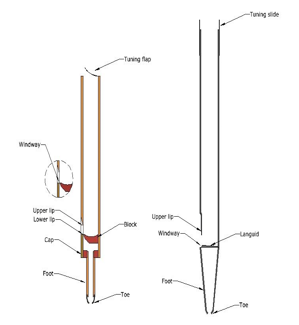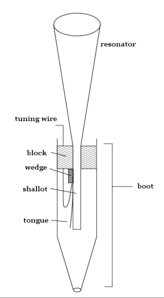The four manuals are used to control different divisions of the organ pipes. Several ranks together are referred to as a "division." The pipes in a division are usually controlled by a single keyboard. Our organ will have a Great division, a Swell division, a Choir division, a String division, a Solo division and a Pedal division.
- The Great (or Great Organ) division usually contains the instrument's most important and widely used stops. This division will be controlled by the second keyboard from the bottom of the four keyboards. Exact specifications of the divisions can be found at the end of this article.
Our exposed Great division will contain the following:
16 Bourdon with 97 pipes i
8 Diapason with 61 pipes
4 Octave with 61 pipes
4 Harmonic Flute with 61 pipes
2 2/3 Twelfth t.c. with 49 pipes (it uses 12 pipes from the 4 Octave) ii
2 Fifteenth with 61 pipes iii
1 1/3 Mixture II with 183 pipes ivOut of sight in the Great Division will be other ranks such as the 8 Viola de Gambe, the 16 Trompette and the 8 Trompette for a total of 16 ranks, some of which will be also used in other divisions. Exact specifications of the divisions can be found in Appendix C. Our organ also can replicate 17 ranks in the digital component to complement the pipes in the Great division.
- The pipes in the Swell division, controlled by the third keyboard from the bottom, are encased behind wooden shutters, which the organist can open and close. This makes the music get louder or quieter (crescendo or diminuendo). The organist operates the swell box with a pedal just above the pedal board. There are 17 ranks of pipes in our Swell division. Our organ also can replicate 18 ranks in the digital component to complement the pipes in the Swell division.
- The Pedal division will use many of the ranks in the Great Division, especially the 16 Bourdon for the lower notes. The Pedal division also lists a 32 Resultant, which is unusual in that it is not really a rank with tallest pipe of 32 feet. This is done by having two pipes, one pipe of the note being played, and its fifth being sounded at the same time. The result is heard as a pitch of one octave lower than the actual note being played. This application is useful especially in the lowest ranks of the pipe organ where cost or space could prohibit having such a rank. Our organ also can replicate 20 ranks in the digital component to complement the pipes in the Pedal division.
- The Choir division contains soft stops which are suitable for accompanying the choir and is controlled by the bottom manual. Our organ has 12 ranks of pipes in the Choir division, complemented by 13 ranks in the digital component.
- The fourth manual is called the Solo because the stops on this manual are often used to play out the tune as a solo. The manual for this division is the top of the four manuals. The Solo division has stops with voices like the French horn, the clarinet, the flute and a loud stop called the 16 Tuba Mirablis. Our organ has no pipes in this division, but is implemented only in the digital component.
i The 16 Bourdon rank has 97 pipes because it would have the normal 61 pipes of a rank, with 12 shorter pipes added, allowing the next octave, making it the equivalent of an 8 foot Bourdon. Another 24 pipes allows still 2 more octaves, allowing the rank to also be used as 4 foot and 2 foot Bourdons. The 61 pipes + 12 + 24 equals 97 pipes for this rank.
ii The 2 2/3 Twelfth plays the third harmonic (or overtone). For example if C is played on the keyboard, the G pipe in the next octave is used. This G is an octave plus a fifth, or 12 keys higher.
iii The 2 Fifteenth is the fourth harmonic or overtone, two octaves above the fundamental, since the interval between the fundamental and the overtone is called a fifteenth.
Note: the fifth harmonic is two octaves plus a third higher. The low C key will play the E pipe two octaves higher. This is done in the 1 3/5 Tierce t.c. rank in the Swell division
iv The 1 1/3 Mixture III plays the sixth harmonic. If the low C is played, the G two octaves higher is played. This G is two octaves plus a fifth higher. The III means that a mixture of 3 pipes will be used with each note. Therefore the rank will require 61x3 or 183 pipes.
“Among the musical instruments that have a place in church, the organ rightly holds the principal position, since it is especially fitted for the sacred chants and sacred rites. It adds a wonderful splendor and a special magnificence to the ceremonies of the Church. It moves the souls of the faithful by the grandeur and sweetness of its tones. It gives minds an almost heavenly joy and it lifts them up powerfully to God and to higher things.” (Pius XII, 1955) Appendix A. Pipes

Organ pipes are of two forms, flue pipes and reed pipes. Flue pipes may be made either of wood or metal. The diagram on the left pictures a wood pipe and the right a metal pipe, usually made of tin and lead.
When a constant supply of compressed air is delivered from the toe to the mouth of the pipe, the speaking length of each pipe acts as an air resonator that develops standing waves in the column of air contained in each pipe. The oscillating air pressure is radiated as sound to the ambient air from the two openings of the flue pipe: 1) at the top end of the resonator, and 2) at the mouth of the pipe. Some flue pipes produce sounds unique to the pipe organ which come to mind in the context of traditional church music. Others may sound like flutes or even strings.

The reed pipe is similar to a single reed orchestral instrument. The wind flowing through the pipe vibrates a metal tongue, a strip of flat metal, against an open-faced shallot. This is not visible from the outside because these parts are contained in the boot, the bottom part of the pipe which rests on the wind chest. The sound is amplified by the resonator, the top, flared part of the pipe. Pitch is determined by the length of the tongue, not by the length of the resonator of the pipe.
The longer the resonator, the bolder and more penetrating the sound produced. The volume – and in this reed pipes do resemble flue pipes – depends on the air pressure as well. The higher the air pressure the louder the sound.
Reed pipes are tuned with the tuning wire that controls how much of the tongue is allowed to vibrate. In order to make tuning easier and quicker the tuning wire is made to stick out of the block so that it be easily raised or lowered to adjust the pitch.
Reed pipes have a strong, penetrating tone and are used to produce the sound of trumpets and oboes, as well as many other voices.
